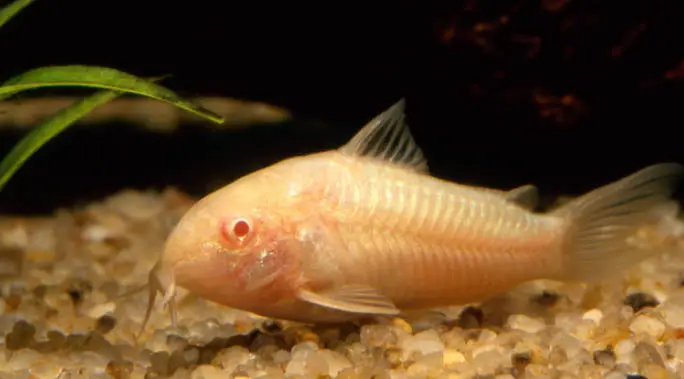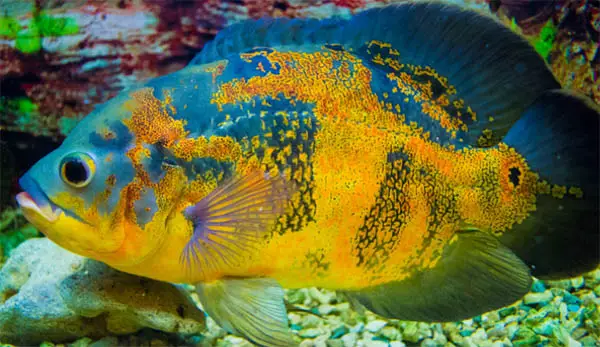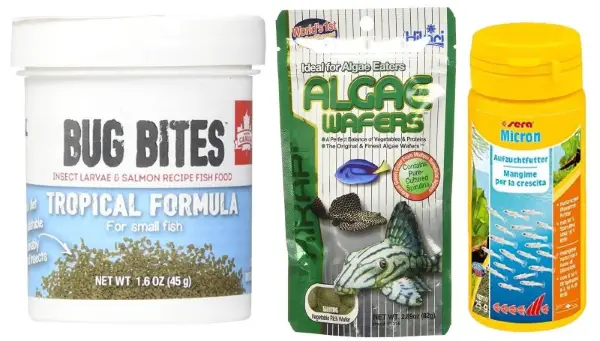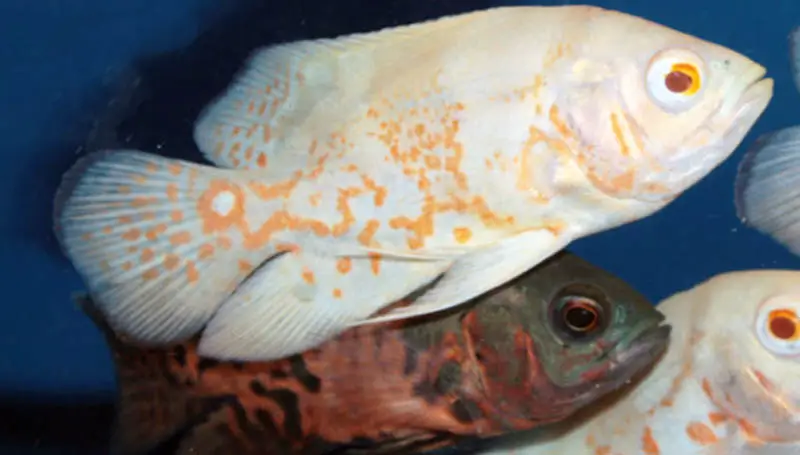In the wild, oscars have a brown base with orange stripes or patches. But in our fish stores, I’m sure we’ve all seen oscars with a white base instead of a brown base.
Naturally, we might think “oh, a white form of a fish I know… it must be an albino form!”

And with oscars, that probably isn’t the case. A white oscar in a fish store, or even the one you might have had in your tank for years, almost certainly is not an albino.
So, What Are They If They’re Not Albinos?
“That’s not an albino oscar, it’s a lutino oscar!”
That’s a popular comment online, isn’t it? But, that might not be correct either. It really depends on the definitions of albino and lutino, as well as the specific facts about the coloration of any individual fish.
In this article, I’m going to go into some detail about color irregularities in animals and how they relate to white oscars.
What Is An Albino?
First, let’s talk about what an albino is; because, there are differing (and effectively conflicting) definitions online. Even Wikipedia editors can’t seem to settle on one exact definition.

And I think I know why! It’s all to do with chromatophores, and how mammals differ versus fish, reptiles, and amphibians when it comes to coloration.
What Are Chromatophores?
Keeping it simple, chromatophores are responsible for pigment in most animals. There are different types of chromatophore for different pigments: yellow comes from xanthophores, red from erythrophores, blacks and browns from melanophores, and cyanophores give us blue. With oscars we’re interested in the reds, yellows, and black/browns.
How Does This Relate To Oscars And Albinism?
This is relevant to any discussion about what constitutes an albino because, according to one definition, an albino organism has no pigment whatsoever. Therefore, an albino appears white, sometimes with a pinkish color to the skin, along with red eyes. The pinks and reds come from the animal’s blood, rather than pigment deposits from chromatophores.
That might seem like a decent enough explanation of what albinism is, but it gets a bit complicated when we consider a second, and quite prevalent, definition of albinism. A lot of people simply define it as a lack of melanin, i.e. black and brown coloration.
Oscars Have Red, Yellow, And Brown/Black Pigments
So, you can probably start to gather why these conflicting definitions are important when talking about whether your oscar is an albino or not. Wild form oscars have that brown base that comes from melanin, but they also have reds and yellows.

Putting it in a nutshell, the argument is whether albinos have no pigment or just no black/brown pigment.
What Have Mammals Got To Do With It?
Above I mentioned different colors in animals: cyanophores (blue), xanthophores (yellow), erythrophores (red), and melanophores (black/brown).

Fish, reptiles, and amphibians come in a wide range of colors. Whereas mammals possess a comparatively limited range of colors. This is because mammals only have melanin for pigment. So, therefore, if you remove the melanin from a mammal then it is, by any definition, an albino.
Is Your Oscar An Albino?
By comparison, when it comes to fish like our oscars, if you remove melanin then you’re still left with yellow and red pigments. So, an oscar without melanin does not lack all pigment and is not, by one definition at least, an albino.
This fundamental difference in pigmentation in mammals versus fish is where a lot of the confusion stems from, I think.
So, If White Oscars Aren’t Albinos… What The Heck Are They?
A popular answer is “lutinos” and it’s a fairly good candidate. But, there are other terms for color morphs in animals and I’m looking at a few that could best fit our white based oscars.
What Is Amelanism?
This is a good one. Amelanistic just means that an animal has no melanin. So, if you have a white oscar with no brown or black coloration whatsoever, then you can be fairly confident that you have an amelanistic fish.
But, some white oscars do have a little bit of black or brown. Especially juveniles. It often manifests on the edge of the caudal fin and sometimes even on the body. If this black coloration is caused by melanin, then you don’t have an amelanistic fish.
Lutino Is What Most People Seem To Call White Oscars. Is That Right?
Maybe!
Lutino is a word we’ve borrowed from birdkeepers. So, I’m going to look to them see if I can apply their concept of lutino coloration to our white based oscars.

A lutino bird is a bird that exhibits xanthochromism. This means that a bird has an unusually yellow coloration. Xanthochromism is often associated with a lack of red pigment, but it does not depend on it.
Would you say white oscars are typically “unusually yellow”? Well, I think some of them are. But, I’d say most are white and orange. So, if displaying atypical yellow coloration is what makes an animal a lutino then I would suggest it might not be the bext term to describe our white based oscars.
But, hold on a second, because lutino is a term that is also sometimes applied to amelanistic animals! So, I mentioned above, amelanistic is often a fitting term for our white oscar fish.
So, if you subscribe to the idea that lutino animals are amelanistic, then lutino is a good word to use to describe our white oscars.
And How About Leucism?
Okay, so lutino is a decent term for white oscars, but is there something better? How about calling them “leucistic oscars”?

This is a good option because it means a partial loss of pigment. So, oscars without their natural brown pigment are, by this definition, leucistic; i.e. they’ve lost a lot of their black/brown pigment but have retained their red/yellow pigment.
Mutual Exclusivity
You might have noticed that some of these terms are compatible with each other. For example, an amelanistic oscar is also a leucistic oscar because it lacks melanin which is also only a partial loss of pigment.
Conclusion
It’s important to remember that being understood is, in my opinion, much more important than being exactly correct. Sure, being correct is helpful, and it contributes to better understanding.
But hey, let’s be honest, we all know what somebody means when they say that they have an “albino oscar”.
And the same goes for “lutino”.
If you find yourself wanting to correct somebody, be careful how you approach that because some people might be offended if you come across as overly nit picky.
And, when you consider that many of these terms are contested, it’s difficult to be sure that you are right! Language evolves based on popular usage, so if it’s popular to call white oscars “lutino” then (whether “correct” or not) that’s what we should concede to calling them.
Either way, we love our oscars, no matter what color they are and no matter what labels we put on them!
If you enjoyed reading this article, then check out my article on goldfish coloration. It goes into more depth about what’s going on “behind the scales” when it comes to the colors of our fish.
It’s Not Just Lutino/Standard – There Are Other Types Of Oscar!
No Matter What Your Fish Is, You Need Good Food To Bring Out Color
Like the subheading says, good food is always a component to bringing out the best in your fish. So, I’ve put together a list of some of my favorite fish foods. Please, check it out!




